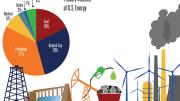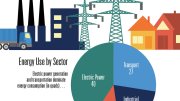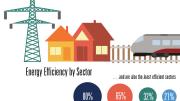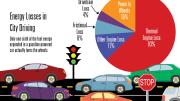Of the nearly 100 quadrillion British thermal units of energy (BTUs) used each year in the United States, 61 quads are wasted. That is not a moral judgment, or a commentary on insufficient conservation (poor insulation, idling cars, people failing to turn off lights when they leave a room). It is, as Mara Prentiss notes, predominantly fundamental physics: the fuel is burned, but less than 50 percent performs useful work. That is because the American economy depends on heat engines—such as fossil-fuel-burning electric power plants and gasoline-powered cars—that cycle to convert heat energy into mechanical work. Their efficiency, the Mallinckrodt professor of physics explains, is limited by the laws of thermodynamics. An electric power plant’s theoretical maximum efficiency (its “Carnot limit”) is approximately 50 percent; a car engine tops out roughly 10 percent lower. In practice, of course, actual efficiencies can be much worse (although modern gas-fired power plants approach the theoretical efficiency limit). What this means is that the energy economy of the United States, as currently structured, can never be much more than 50 percent efficient: the laws of physics won’t permit it.
Prentiss sees in this fundamental limit to efficiency not an obstacle, but an opportunity. In her new book, Energy Revolution: The Physics and the Promise of Efficient Technology (Harvard University Press), she probes the most basic of questions: where energy comes from, how it is distributed, how it is consumed, and—critically—how it is wasted.
Prentiss is a specialist in the manipulation of matter by light, who now focuses principally on using the tools of physics to answer knotty biological questions. She decided to write her book for a wider audience, given the urgency of the energy problem, the relevance of fundamental principles of physics, and the opportunity to apply her skills to U.S. energy challenges. She aims to show what choices the country really has, and how realistic the path to a sustainable future might be.
Without plunging directly into current energy-policy debates, Prentiss offers a uniquely scientific perspective on what she calls one of the biggest single problems facing humanity. Beyond the connection between long-term climate change and the use of energy, and the immediate environmental impact of fossil-fuel emissions (including lead, mercury, oxides of nitrogen and sulfur, carbon monoxides, ozone, and particulate pollution), lies another stark reality: the total quantity of fossil fuel on earth is finite, and so, inevitably, eventually, “We will run out,” she says. What then? Could humanity generate enough power from sun, wind, and water to replace fossil fuels, so that they gradually became a tiny fraction of consumption? Would that require sacrifices, and sweeping lifestyle changes?
In the book, Prentiss aims both to provide a factual basis for making decisions about personal energy use and to inform public policy. Thus, she applies her scientific knowledge and analytical skills to the task of explaining how the components of the U.S. energy economy interact—often, grossly inefficiently. She explains the mechanics of power generation (from wind turbines to hydroelectric dams) and consumption (in lighting, appliances, or cars). Most surprisingly, she concludes that the opportunity to shift to renewables right now already exists—without sacrifices to Americans’ lifestyle. “New technologies are allowing things that were previously impossible,” she says. “We are on the cusp of an energy revolution, which might significantly improve the lives of everyone on earth, if only we have the courage to seize the opportunity.”
Prentiss envisions an economy based almost entirely on renewable sources of energy. Wind and solar power could meet the average total energy demand in the United States now and for the next 50 years, she says, even without eliminating wasted energy—a conclusion, based on the underlying physics, that may at least provide policymakers and consumers with some grounding for sound decisions. But meeting peak energy demand nationwide with renewable sources will require not only political and social change, but also a revolution in thought and practice. That revolution involves wide adoption of existing energy-efficiency technologies, computing advances that enable constant system adjustments to improve both comfort and efficiency, a broader approach to energy storage, and “smart grids that pool energy supply, demand, and storage over large geographical areas.”
Achieving those goals may seem “highly improbable given human resistance to change,” Prentiss writes in the first sentence of Energy Revolution, “but an examination of historical energy use indicates that humanity has already undergone several energy consumption revolutions.” An age of wood throughout the colonial era gave way to an age of coal in the nineteenth century, and then to an age of diversified energy sources in the twentieth, she points out. Both wood and coal remain a part of the energy economy: in fact, the United States burns as much coal as ever, though oil and natural gas have increased in importance. Today, approximately 80 percent of U.S. energy comes from fossil fuels. Another transformation—entailing a shift from use of fossil fuels to electricity generated with renewable sources—is “not only possible, but probable.”
A Renewable-Energy Thought Experiment
How difficult would it be to replace fossil-fuel consumption with renewable sources? To find the answer, Prentiss undertakes a thought experiment using wind power.
Energy from onshore wind costs 8 cents per kilowatt hour (kWh) for new installations: cheaper than the 9.6 cents per kWh for power generated from coal, but more expensive than the approximately 6.6 cents per kWh for natural gas (notably, the latter two numbers do not include related health or climate-impact costs). Total U.S. energy consumption (including, for example, heating and transportation) is equivalent to seven times the energy consumed in the form of electricity—so to generate enough power to satisfy all energy demand using wind alone, the country would need to install turbines in a north-to-south vertical stripe covering the middle, windiest, third of the nation.
As with real estate, the key to wind turbines’ value is location, location, location. The power generated by a wind turbine increases with the cube of the wind speed, so the difference in energy potential between a site where the winds average five miles per hour and one where they average eight mph is substantial: the latter site can generate more than four times as much electricity (5 x 5 x 5 = 125 versus 8 x 8 x 8 = 512). The power output of a wind turbine also increases with the square of the rotor radius, so doubling the rotor length quadruples power output. There are further refinements, but these rules, combined with the fact that wind speeds increase with height, mean that, in practice, really big towers supporting large turbines in windy locations are the most efficient. (Offshore sites are suitable from the standpoint of wind speeds, but Prentiss says the cost of electricity generated by offshore wind farms is twice as high, reflecting high construction, maintenance, and transmission costs.)
But covering one-third of the nation in wind turbines sounds draconian. It could have a harmful impact on predatory birds; it might also affect weather, Prentiss notes, and that should be studied. But if those turbines were built, landholding ranchers and farmers become the oil barons of the twenty-first century. In an electrified economy, people would drive electric cars, which would raise demand for electricity and lower demand for gasoline; fossil-fuel power plants would slowly be phased out. Existing plants would not be required to shut down prematurely, so electricity providers would not be hurt. A decrease in U.S. demand for petroleum would allow Americans to reduce petroleum imports, and might even enable substantial petroleum exports. Above all, the country would need only half as much energy as it uses today—because replacing fossil-fuel-dependent cars and power plants with renewably generated electricity would immediately reduce total energy demand by more than half (by eliminating that fundamental Carnot limit on efficiency). That means that instead of covering a third of the country, wind turbines would need to cover less than a sixth ofthe nation’s land area to meet average demand with wind power alone. Such a system would also dramatically reduce emissions associated with burning fuel.
The necessary land area would shrink further if contributions from solar, hydroelectric, biofuels, and nuclear energy were factored in, and still further with increased adoption of energy-efficiency technologies. (Prentiss notes that solar power alone could, like wind, in theory supply all of the nation’s energy needs, albeit more expensively.) Furthermore, land that hosts wind turbines can still be used for other purposes, such as growing crops, grazing cattle, or even raising biofuel. Turbines take up very little space on the ground, she points out, so on nonarable land, owners could produce even more power by co-locating solar panels among them. (Existing estimates of the land area needed for renewables, she says, generally don’t consider dual-use possibilities, and therefore overestimate the acreage required.)
Challenges to a Renewable-Energy Economy
Prentiss identifies three considerable challenges to this vision of a national renewable-power system: the long-distance transport of electricity; the intermittency of the wind and sun; and the limited capacity to store renewably generated energy for later use.
Transporting electricity from the nation’s heartland to the coasts, or from north to south, or from one coast to the other, would require building a national power grid, a substantial infrastructure investment. But science demonstrates that electricity travels well, Prentiss explains, especially in the form of direct current (as opposed to the alternating current that utilities deliver to customers). The U.S. Energy Information Agency estimates total transmission losses at approximately 6 percent, with long-distance losses around 5 percent per 1,000 miles for high voltage direct current. Such a loss in income might drive an accountant (like her spouse) crazy, Prentiss acknowledges, but “scientists talk in factors of two and 10”: thus, losses from distribution of electricity across thousands of miles are not big when compared with the orders-of-magnitude differences in generating capacity between the country’s most and least windy locations.
The intermittency of wind and solar power is a bigger problem, she admits. Solar panels can’t make electricity when the sun doesn’t shine, whether at night or during cloudy weather. And on windless days, turbines stand idle. Today, regional utilities cope with this problem by maintaining conventional, fossil-fuel-powered electric plants with sufficient capacity to cover any renewable-source fluctuations. As of 2012, wind power represented just 1 percent of U.S. energy sources, but Iowa and South Dakota both generate more than 20 percent of their electricity from wind (as does Germany), demonstrating that fluctuations in supply and demand can be managed.
As the role of renewable energy grows, of course, the intermittency problem becomes more challenging. Supply fluctuations are potentially more dramatic when there are more renewables in the energy mix, and could thus require more fossil-fuel backups to compensate. The simplest solution would be a breakthrough in storage technology, but Prentiss believes the challenge can be managed even without such an advance by combining existing storage solutions with a “smart grid.” Hydroelectric power, she says, provides today’s best large-scale means of storing energy generated from the wind and sun. Water stored in reservoirs and behind dams can be released to generate electricity as needed—and excess intermittent renewable power could be used to pump water up into reservoirs, to be released later when demand exceeds supply.
Given that hydroelectric power is itself a renewable, why doesn’t the United States make it the center of a renewable energy policy? In her book, Prentiss addresses this question as another thought experiment. First, she calculates how much rain falls across the entire country, and then asks how much power all that water could generate, if every drop could be captured and stored for use. The answer, she says, is 7 percent of total U.S. energy demand: “Not enough.”
In fact, hydroelectric capacity in the United States has remained steady since 1970, because development of new generating facilities has been offset by the removal of dams, principally due to environmental concerns. As the nation’s energy use has grown, therefore, hydroelectric’s contribution to the total supply has gradually dwindled.
Because the nation’s pumped-storage hydroelectricity is limited, Prentiss suggests that, barring a technological breakthrough, meeting total U.S. power needs during the next 50 years will require combining existing storage capacity with a national smart grid.
A smart grid that uses computers to manage electricity could take advantage of regional differences in power supply and demand, thereby decreasing the need for energy storage, that third big problem with renewables. For example, the sun sets almost four hours earlier on the East Coast than on the West (not three, as the time difference would suggest). Solar power generated in the West could be sold to customers in the East. Likewise, power demand changes seasonally, and according to different patterns in the South than in the North, creating opportunities for transferring electricity among states at different latitudes. Finally, the variability of wind averages out over distances of 1,000 kilometers or more, so a smart grid that stretched across the entire continental United States would be able to deliver a steadier flow of electricity from wind by managing long-distance transfers of power. Smart grids can also take advantage of distributed energy storage. Existing battery packs for electric cars can store approximately three times the electrical energy consumed by a household in a day. If every household had such a battery pack, the energy storage would approach the total daily U.S. electricity consumption.
Toward a Renewable-Energy Economy
What is a sensible path forward? Prentiss says she wrote Energy Revolution out of a conviction that information is a powerful way to help people make decisions about energy use, whether as citizens or consumers.
In order to effect change, then, her decision to focus on the largest, most inefficient sectors of the U.S. economy is pragmatic. Using government data, she divides consumption into four sectors and ranks their efficiency: industry, 80 percent efficient; residential/commercial, 65 percent efficient; electric-power generation, 32 percent efficient; and transport, 20 percent efficient. The data also reveal that the most efficient sectors are the smallest. Of the nearly 100 quads of energy used in the United States annually, 20 quads are consumed by industry, and 11 go to commercial/residential uses. Transportation, the most inefficient sector by far, consumes 27 quads of energy, more than a quarter of total U.S. use, while electric- power generation uses 40 quads.
The largest, most inefficient sectors thus represent more than two-thirds of total energy consumption, and are the logical focus for moving the economy toward a sustainable future. The most wasteful example is a gasoline-powered car driven in the city. The inefficiency begins with the engine itself, subject to the Carnot limit (the thermal engine loss exceeds 65 percent of the energy in the fuel burned), and mounts from there: drivetrain losses, 4 percent; parasitic (frictional) losses, 6 percent; and other engine losses, 11 percent. In the final analysis, says Prentiss, just 16 percent of the energy actually moves the wheels. Of every six gallons of gasoline burned, in other words, only one moves the car. (In more efficient highway use, one gallon in four goes to turn the wheels—a yield of 25 percent.)
Electric cars are far more efficient. Their motors waste a negligible amount of power (efficiencies can approach 99 percent), and regenerative brakes allow them to recapture and reuse much of the energy that propels the car. Overall, existing electric cars have total efficiencies that can exceed 60 percent. Thus, if gasoline-powered cars were completely replaced by electric cars, the electrical energy required to fuel them would be less than one-third the energy previously supplied by gasoline. But Prentiss is not advocating that everyone buy an electric car now. That would cause demand for electricity to spike, and force utilities to burn more fossil fuels.
Getting to efficient electric vehicles, in other words, also requires system change. The efficiency of the car (and its impact on emissions) is only as good as the efficiency of the plant that generates the power used to charge the battery. If the power to run those cars comes from a wind turbine or a solar panel on the roof of a home, then the electric car makes sense.
An energy economy based on electricity, including electric cars, must therefore grow gradually, Prentiss argues, with sources of supply and demand expanding in tandem in order to capture the efficiencies gained by eliminating heat engines. Furthermore, utilities must carry the capital costs of fossil-fuel-burning power plants on their books even as new renewable-power plants come on line. Her data show that meeting growth in demand for electricity (energy use grows over time) by building new renewable energy plants, without decommissioning fossil-fuel plants before the end of their lives, leads to the smoothest transition to a sustainable economy.
Shaping the Path Ahead
Prentiss is realistic about the potential for change. Jets would still need to run on liquid fuel; doubling production of ethanol, a biofuel, could meet that need, she suggests. And even if the contiguous 48 states were to be linked by a single electric grid optimally combining wind, solar, hydroelectric, and geothermal power, she says that it would be more economical, in the near future at least, to burn some natural gas as part of that mix.
A shift to renewable energy is already under way in the United States. In 2012, renewables passed nuclear power in the amount of electricity generated. Most of that new power came from wind and biofuels, the fastest-growing contributors to the the nation’s renewable sector. In addition, society is on the verge of benefiting from new kinds of efficiency gains. Computing advances, for example, could enable real-time modulation of supply and demand: imagine a hot summer day when air conditioning causes the demand for electricity to spike—and the batteries in electric cars provide a buffer during peak power use. Consumers could agree to run certain “smart” appliances such as dishwashers or dryers only when power demand for the day has ebbed. (Read about two alumni applying these technologies with utilities today.) Though Prentiss’s calculations don’t encompass this type of efficiency gain, nor the “socially wasted energy” expended heating and lighting empty rooms, idling in traffic jams, or driving around looking for a parking space, she points out, for example, that “smart” meters that signal whether parking spaces are occupied would be a win for everyone.
“Most people aren’t aware of the enormous positive opportunities for change” right now, Prentiss says. “I wrote the book to encourage people to embrace some of those changes.” To make good decisions, she continues, “it helps to be aware, not just of the obvious, but of the slightly less obvious. And in the end, I make some suggestions that have a factual basis, but it’s my hope that people decide things for themselves. My goal is that you don’t go on faith, and that in fact, you think about it for yourself.”













